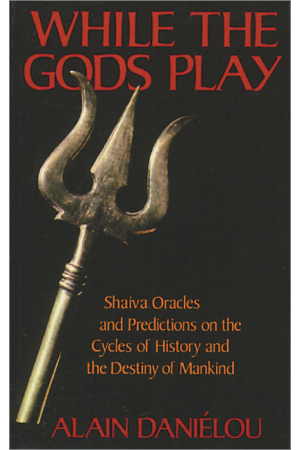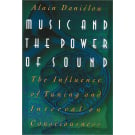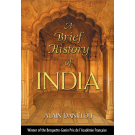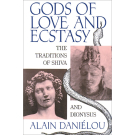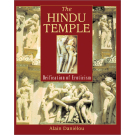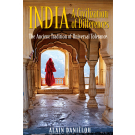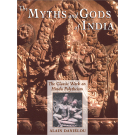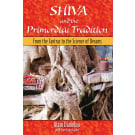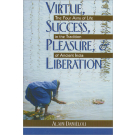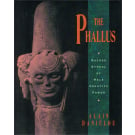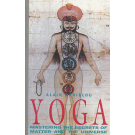While the Gods Play
Shaiva Oracles and Predictions on the Cycles of History and the Destiny of Mankind
- Pages: 304
- Book Size: 5.25 x 8.5
- ISBN-13: 9780892811151
- Imprint: Inner Traditions
- On Sale Date: August 1, 1987
- Format: Paperback Book
This prediction is only a fragment of the vast knowledge of Shaiva wisdom, author Alain Danielou as assimilated and reviewed essential concepts of the Shaiva philosophy and its predictions. Clearly expressed in the ancient teachings, these concepts are in accord with, yet surpass, the boldest scientific speculations about consciousness, time, the nature of life and matter, and the history and destiny of the human race.
Inherent in this body of knowledge is an understanding of the cycles of creation and destruction which, in conjunction with astronomical phases, determine the life span of the species. Since 1939, humankind has been in the twilight of the Kali Yuga age, or at the end of a cycle. The impending cataclysm, Danielou explains, is brought on by our own errors, and its date will be determined by our present and future actions.
While the Gods Play examines how the visionaries of ancient times defined our rose in creation. It explains why and how we have abandoned this role, and reflects on what action can be taken to consciously and creatively influence our own destiny. Included are chapters on The Religion of Nature and The Religion of the City, The Transmigrant Body, Sexual Rites, the Castes, Sacrifice, Magical Powers, Monastic Orders, and Forestalling the Final Day.
Note on the Transliteration of Sanskrit Terms
Introduction to the American Edition
PART ONE: THE HUMAN ADVENTURE
1. Origins
The Dravidians, 6 / The Aryans, 9
2. The Religions of the Kali Yuga
Shaivism, 15 / The Return of Arihat, 16 / Gosalii, 17 / Mahavfra, 22 / Gautama Buddha, 23 / The Religion of Nature and the Religion of the City, 24 / The Kali Yuga in the World, 25 / The Shaiva Revival, 27 / Lakulisha, 27 / Mahayana, 29
3. Rediscovered Tradition
The Texts, 31 / Hindu Decadence, 35 / The West, 38 / India Today, 39
PART TWO: SHAIVA PHILOSOPHY
1. The Ways of Knowledge 43
Approaches (Darshana), 43
2. Valsheshika and Nyaya 46
Science and Logic, 46 / The Experimental Method (Vaisheshika), 47 / Logic (Nyaya), 50 / Aphorisms of the Nyaya, 53
3. The Samkhya: The Study of the Macrocosm
The Quest for Constants (Akshara), 57 / The Texts of the Samkhya, 58 / Concepts of the Samkhya, 59 / Nature and Perception, 63 / The Three Tendencies of Prakriti, the Nature of Nature, 65 / The Definables (Tattva): The Twenty-five Constituents of the World, 67 / The Plan (Purusha), 67 / The World-Substance (Prakriti), 68 / Cosmic Intelligence (Mahat), 69 / The Principle of Individuality (Ahamkara), 69 / The Modes of Interaction of Matter (Tanmatra), 71 / The Principles of the Senses (Mahabhuta), 71 / The Powers of Perception and Action (Indriya), 73 / The Living Being, 75
4. The Exploration of Man's Inner Universe
The Being of Flesh and the Being of Knowledge, 78 / The Sexual Body (Linga-Sharira) or Transmittable Body, 79 / The Nature of the Transmigrant Body, 81
5. The Being of Knowledge
Universal Law (Sanatana Dharma) and the Heritage of Knowledge, 84 / The Seers (Rishi), 86 / The Sacred Books, 87
6. Yoga
Yoga: Study of the Microcosm, 89 / Method, 90 / The Structure of Living Beings, 92 / The Five Vital Energies (Prana), 92 / Magic Powers (Siddhi), 94 / Reincarnation, 97 / Transubstantiation, 98 / Liberation (Moksha), 99 / Immortality, 100 / Yoga and Tantrism, 100 / Aryanized Yoga, 101
PART THREE: THE MIMANSA: THE RELIGIOUS, RITUALISTIC, AND MYSTICAL APPROACH
1. The Two Mimansa
The Gods, 109 / Aspects of Maheshvara, 111 / Shiva, Tamas, 112 / Sattva, the Goddess, and Vishnu, 112 / Rajas, Prajapati-Brahma, 114 / Symbols of the Gods, 114 / The Cult of the Linga, 115 / The Assimilated Gods, 116 / Monotheism, 117
2. The Doctrine of the Pashupata
The Teaching of Lakulisha, 120 / Texts, 121 / Pashupati: Lord of the Animals, 122 / Pati: The Herder, 122 / Pashu: The Animal, 123 / Pasha: The Snare, 123 / The Creative Power of the Sovereign Being (Ishvara-Kartri-Vada), 124 / The Cause (Karana), 124 / The Work (Karya), 125 / Divisibility (Kala), 125 / Method (Vidhi), 126 / Meritorious Deeds (Kriya), 126 / The Temple, 126 / Union (Yoga), 128 / The End of Suffering (Dukhanta), 129
3. Communities and Monastic Orders
Monastic Orders, 130 / The Black Faces (Kalamukha), 132 / The Skull-Bearers (Kapalika), 133 / Practices (Charya), 135 / The Five M's, 136 / Mala and Mutra, 137 / Meat (Mansa) and Sacrifice (Medha), 137 / Human Sacrifice, 138 / Intoxicating Liquors (Madhya), 139 / Drugs, 140 / Sexual Rites (Maithuna), 141 / Love and Death, 142 / The Great Vow (Mahavrata), 144 / Initiation of the Pashupata, 145
4. Preliminary Practices
Advice to a Mleccha, 149
PART FOUR: SOCIAL MAN
1. The Individual and the Species
The Clan (Jati), 158 / Procreation, 161 / The Castes (Varna), 162 / The Lineage (Gotra), 165 / The Popular Framework, 166 / Coexistence, 167 / Woman, 170 / The Family (Kula), 171 / The Servants of the Gods, 172 / The Third Nature (Tritiya Prakriti), 173
2. The Transmission of Knowledge
The Master (Guru), 179 / The Guru's Responsibilities, 180 / The Limits of Knowledge, 181 / The Choice of a Disciple, 182 / The Wanderers of the Path of Knowledge (Brahmachari), 184
PART FIVE: THE THEORY OF CYCLES
1. The Duration of the Universe
The Cycles of the Yuga, 194 / The Flood, 198
2. The Three Cities
The Ages (Yuga), 200 / The Destruction of the Assurs, 201
PART SIX: FORESTALLING THE END
1. Predictions
Precursory Signs, 211 / The End of the World, 216 / Accidental or Induced Destruction (Naimitta Pralaya), 217 / The Disappearance or Natural Death (Prakrita Pralaya) of the World, 219
2. Forestalling the Final Day
The Return to Shaivism, 222
3. Conclusions
APPENDIX I. LANGUAGE: INSTRUMENT FOR THE TRANSMISSION OF KNOWLEDGE
The Nature of Language, 227 / The Manifestation of Thought, 228 / Texts, 232 / The Maheshvara Sutra, 235 / The Nine Vowels, 238 / The Consonants, 243 / The Five Groups (Varga), 243 / The Tattva, 245 / Creation by the Word, 251 / Monosyllabic Dictionaries, 252 / Magic Formulae (Mantra), 253 / Elements of the Musical Vocabulary, 254 / The Various Forms of Language, 255 / Visual Languages, 256 / A Geometric Language (Yantra), 256 / The Swastika, 260
APPENDIX II. CHRONOLOGY OF THE KALI YUGA
Bibliography
Index
Institute of Hermetic Studies, Nov 2007
This prediction is only a fragment of the vast knowledge of Shaiva wisdom, author Alain Danielou as assimilated and reviewed essential concepts of the Shaiva philosophy and its predictions. Clearly expressed in the ancient teachings, these concepts are in accord with, yet surpass, the boldest scientific speculations about consciousness, time, the nature of life and matter, and the history and destiny of the human race.
Inherent in this body of knowledge is an understanding of the cycles of creation and destruction which, in conjunction with astronomical phases, determine the life span of the species. Since 1939, humankind has been in the twilight of the Kali Yuga age, or at the end of a cycle. The impending cataclysm, Danielou explains, is brought on by our own errors, and its date will be determined by our present and future actions.
While the Gods Play examines how the visionaries of ancient times defined our rose in creation. It explains why and how we have abandoned this role, and reflects on what action can be taken to consciously and creatively influence our own destiny. Included are chapters on The Religion of Nature and The Religion of the City, The Transmigrant Body, Sexual Rites, the Castes, Sacrifice, Magical Powers, Monastic Orders, and Forestalling the Final Day.
One of the most distinguished living orientalists and a friend of Stravinsky, Jean Cocteau, and Nabokov, Daniélou spent more than 20 years in India studying music and philosophy. He wrote the acclaimed Gods of India and Shiva and Dionysus and produced a series of ethnic music recordings for UNESCO. Formerly director of the International Institute for Comparative Music Studies in Berlin and Venice, he is a Chevalier de la Légion d'Honneur, Chevalier des Arts et des lettres, and Officier du Mérite National.



